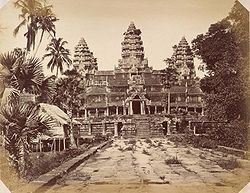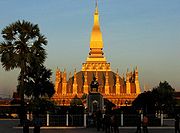
Louis Delaporte
Encyclopedia
Louis Delaporte was a French explorer and artist
, whose collection and documentation of Khmer art
formed the nucleus of exhibitions in Paris, originally at the 1878 Paris Exposition and later at the Palais du Trocadéro, where he became chief curator of the Musée Indochinois. In 1927, after his death, his collection was moved to the Guimet Museum
.

 The first systematic exploration of the Mekong River, considered "the wildest of the world's great rivers," was the French Mekong expedition led by Ernest Doudard de Lagrée and Francis Garnier
The first systematic exploration of the Mekong River, considered "the wildest of the world's great rivers," was the French Mekong expedition led by Ernest Doudard de Lagrée and Francis Garnier
, which ascended the river from its mouth to Yunnan
between 1866 to 1868. Delaporte, a young naval officer, was chosen because of his talent in drawing to accompany them through what was then French Indochina
.
This expedition took the young artist to Angkor Wat
. Years later, in his 1880 book Voyage au Cambodge, Delaporte recorded his impressions:
The detailed drawings Delaporte made on this voyage were used to illustrate Garnier's 1870 account of the voyage. Many years later, during the 1930s, drawings Delaporte had made at Pha That Luang
became the basis for a major reconstruction of that important religious site near Vientiane
. In particular, the first rebuild gave the stupa
a shape that locals found unattractive; based on Delaporte's drawings it was restored to its original lotus-bud design.
The expedition was plagued by disasters and difficulties, including many miles of wading barefoot through knee-deep mud infested with leeches. Nevertheless, the team surveyed and mapped 6,000 km, charting the Mekong's course from its mouth in present-day Vietnam through present-day Cambodia, Thailand, Laos, and Burma into China. At the end of the journey, Delaporte returned to France, where he was promoted to the rank of ship's lieutenant and awarded the Légion d'Honneur
.
(1870–1871) Louis Delaporte obtained the support of France's Geographical Society and of several French government ministries for a new expedition. This mission would have a dual purpose: to map Vietnam's Red River and to bring back Khmer art for exhibition in France.
In May of 1873, his team left France taking with them many gifts, including engravings based on the works of Rembrandt and Rubens
as well as copies of paintings by Nicolas Poussin
and Théodore Gérard. By the end of the expedition, they brought back some 70 specimens of sculpture and architecture, all of which Delaporte affirmed had been acquired by purchase or trade, plus his own drawings, prints, and plans.
, where Delaporte had hoped to see these acquisitions displayed, refused to accept them. Instead, he was invited to set up a museum at the Château de Compiègne
. Then, in 1878, a grand Exposition Universelle
opened in Paris, and many Khmer sculptures and Delaporte drawings were displayed at one of the new exhibition buildings, the Palais du Trocadéro. This display awakened much wider public interest in Khmer art, but it would not be until the foundation of the Musée Indochinois at the Palais du Trocadéro in 1882 that it would have its own gallery space in Paris for public display. On his return from his third and last expedition of 1881–82, Delaporte became its chief curator until his retirement in 1924.
Artist
An artist is a person engaged in one or more of any of a broad spectrum of activities related to creating art, practicing the arts and/or demonstrating an art. The common usage in both everyday speech and academic discourse is a practitioner in the visual arts only...
, whose collection and documentation of Khmer art
Khmer art
The history of Cambodian art stretches back centuries to ancient crafts. Traditional Cambodian arts and crafts include textiles, non-textile weaving, silversmithing, stone carving, lacquerware, ceramics, wat murals, and kite-making...
formed the nucleus of exhibitions in Paris, originally at the 1878 Paris Exposition and later at the Palais du Trocadéro, where he became chief curator of the Musée Indochinois. In 1927, after his death, his collection was moved to the Guimet Museum
Guimet Museum
The Guimet Museum is a museum of Asian art located at 6, place d'Iéna in the 16th arrondissement of Paris, France...
.
French Mekong expedition (1866–1868)


Francis Garnier
Marie Joseph François Garnier was a French officer and explorer known for his exploration of the Mekong River in Southeast Asia.- Early career :...
, which ascended the river from its mouth to Yunnan
Yunnan
Yunnan is a province of the People's Republic of China, located in the far southwest of the country spanning approximately and with a population of 45.7 million . The capital of the province is Kunming. The province borders Burma, Laos, and Vietnam.Yunnan is situated in a mountainous area, with...
between 1866 to 1868. Delaporte, a young naval officer, was chosen because of his talent in drawing to accompany them through what was then French Indochina
French Indochina
French Indochina was part of the French colonial empire in southeast Asia. A federation of the three Vietnamese regions, Tonkin , Annam , and Cochinchina , as well as Cambodia, was formed in 1887....
.
This expedition took the young artist to Angkor Wat
Angkor Wat
Angkor Wat is a temple complex at Angkor, Cambodia, built for the king Suryavarman II in the early 12th century as his state temple and capital city. As the best-preserved temple at the site, it is the only one to have remained a significant religious centre since its foundation – first Hindu,...
. Years later, in his 1880 book Voyage au Cambodge, Delaporte recorded his impressions:
The sight of these strange ruins struck me, too, with a keen astonishment, I admired the bold and grandiose design of these monuments no less than the perfect harmony of all their parts. Khmer art, issuing from the mixture of India and China, purified, ennobled by artists whom one might call the Athenians of the Far East, has remained the most beautiful expression of human genius in this vast part of Asia that extends from the Indus to the Pacific.
The detailed drawings Delaporte made on this voyage were used to illustrate Garnier's 1870 account of the voyage. Many years later, during the 1930s, drawings Delaporte had made at Pha That Luang
Pha That Luang
Pha That Luang is a gold-covered large Buddhist stupa in the centre of Vientiane, Laos. Since its initial establishment suggested to be in the 3rd century, the stupa has undergone several reconstructions until the 1930s due to foreign invasions to the area...
became the basis for a major reconstruction of that important religious site near Vientiane
Vientiane
-Geography:Vientiane is situated on a bend of the Mekong river, which forms the border with Thailand at this point.-Climate:Vientiane features a tropical wet and dry climate with a distinct monsoon season and a dry season. Vientiane’s dry season spans from November through March. April marks the...
. In particular, the first rebuild gave the stupa
Stupa
A stupa is a mound-like structure containing Buddhist relics, typically the remains of Buddha, used by Buddhists as a place of worship....
a shape that locals found unattractive; based on Delaporte's drawings it was restored to its original lotus-bud design.
The expedition was plagued by disasters and difficulties, including many miles of wading barefoot through knee-deep mud infested with leeches. Nevertheless, the team surveyed and mapped 6,000 km, charting the Mekong's course from its mouth in present-day Vietnam through present-day Cambodia, Thailand, Laos, and Burma into China. At the end of the journey, Delaporte returned to France, where he was promoted to the rank of ship's lieutenant and awarded the Légion d'Honneur
Légion d'honneur
The Legion of Honour, or in full the National Order of the Legion of Honour is a French order established by Napoleon Bonaparte, First Consul of the Consulat which succeeded to the First Republic, on 19 May 1802...
.
1873 expedition
After an interruption caused by the Franco-Prussian WarFranco-Prussian War
The Franco-Prussian War or Franco-German War, often referred to in France as the 1870 War was a conflict between the Second French Empire and the Kingdom of Prussia. Prussia was aided by the North German Confederation, of which it was a member, and the South German states of Baden, Württemberg and...
(1870–1871) Louis Delaporte obtained the support of France's Geographical Society and of several French government ministries for a new expedition. This mission would have a dual purpose: to map Vietnam's Red River and to bring back Khmer art for exhibition in France.
In May of 1873, his team left France taking with them many gifts, including engravings based on the works of Rembrandt and Rubens
Rubens
Rubens is often used to refer to Peter Paul Rubens , the Flemish artist.Rubens may also refer to:- People :Family name* Paul Rubens Rubens is often used to refer to Peter Paul Rubens (1577-1640), the Flemish artist.Rubens may also refer to:- People :Family name* Paul Rubens (composer) Rubens is...
as well as copies of paintings by Nicolas Poussin
Nicolas Poussin
Nicolas Poussin was a French painter in the classical style. His work predominantly features clarity, logic, and order, and favors line over color. His work serves as an alternative to the dominant Baroque style of the 17th century...
and Théodore Gérard. By the end of the expedition, they brought back some 70 specimens of sculpture and architecture, all of which Delaporte affirmed had been acquired by purchase or trade, plus his own drawings, prints, and plans.
Khmer art in Paris
The LouvreLouvre
The Musée du Louvre – in English, the Louvre Museum or simply the Louvre – is one of the world's largest museums, the most visited art museum in the world and a historic monument. A central landmark of Paris, it is located on the Right Bank of the Seine in the 1st arrondissement...
, where Delaporte had hoped to see these acquisitions displayed, refused to accept them. Instead, he was invited to set up a museum at the Château de Compiègne
Château de Compiègne
The Castle of Compiègne is a French château, a royal residence built for Louis XV and restored by Napoleon. Compiègne was one of three seats of royal government, the others being Versailles and Fontainebleau...
. Then, in 1878, a grand Exposition Universelle
Exposition Universelle (1878)
The third Paris World's Fair, called an Exposition Universelle in French, was held from 1 May through to 10 November 1878. It celebrated the recovery of France after the 1870 Franco-Prussian War.-Construction:...
opened in Paris, and many Khmer sculptures and Delaporte drawings were displayed at one of the new exhibition buildings, the Palais du Trocadéro. This display awakened much wider public interest in Khmer art, but it would not be until the foundation of the Musée Indochinois at the Palais du Trocadéro in 1882 that it would have its own gallery space in Paris for public display. On his return from his third and last expedition of 1881–82, Delaporte became its chief curator until his retirement in 1924.
Evangelist for the importance of Khmer art
From his earliest encounter with Khmer architecture and sculpture, Delaporte was convinced that it should be compared to the best of Classical art:It differs, indeed, from those great classics of the Mediterranean basin that have long captured our admiration: it is no longer these majestic colonnades, these great calm surfaces of Greece or Egypt; these are, in contrast, forms [that are] laborious, complex, tormented: overlays, multiple withdrawals, mazes, galleries shaded from daylight, jagged towers, pyramids with countless stories and arrows, a great profusion of ornaments and sculptures, constant effects of light and shadow that enrich the whole without altering its majesty, and blend beautifully with the intense light and lush tropical vegetations: it is, in short, another form of beauty.
Publications
- Voyage d'exploration en Indo-Chine by Francis Garnier with illustrations by Louis Delaporte (1873)
- Voyage au Cambodge; l'architecture khmer (1880)
- Les monuments du Cambodge (1924)

